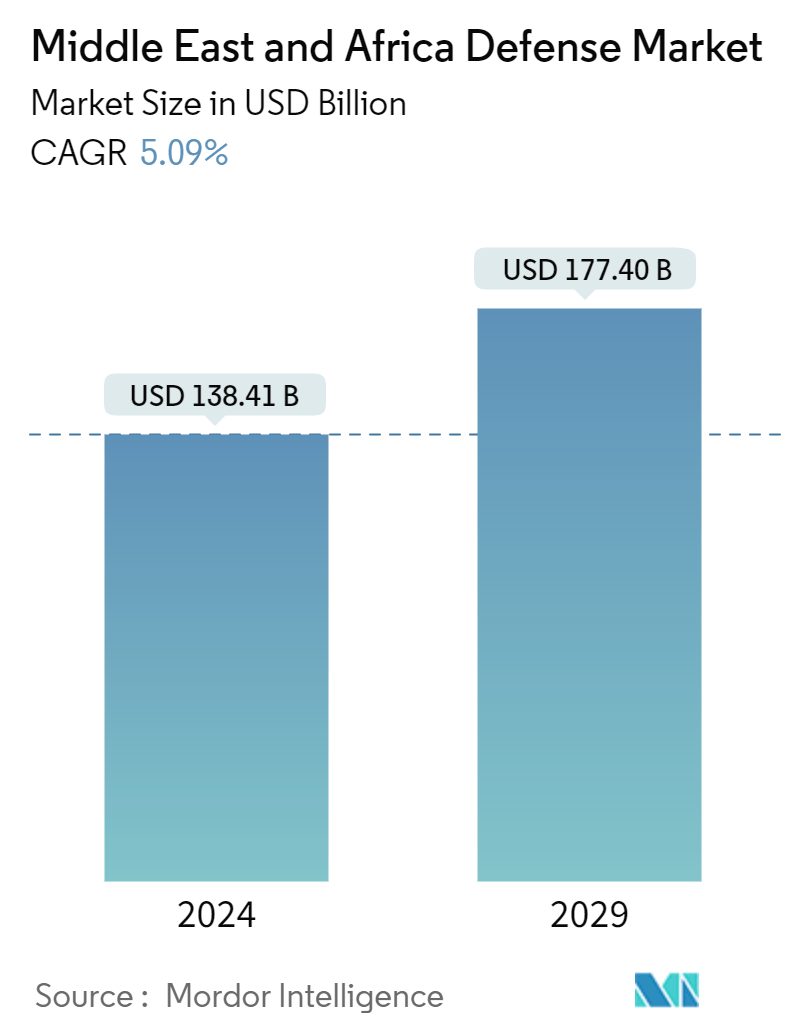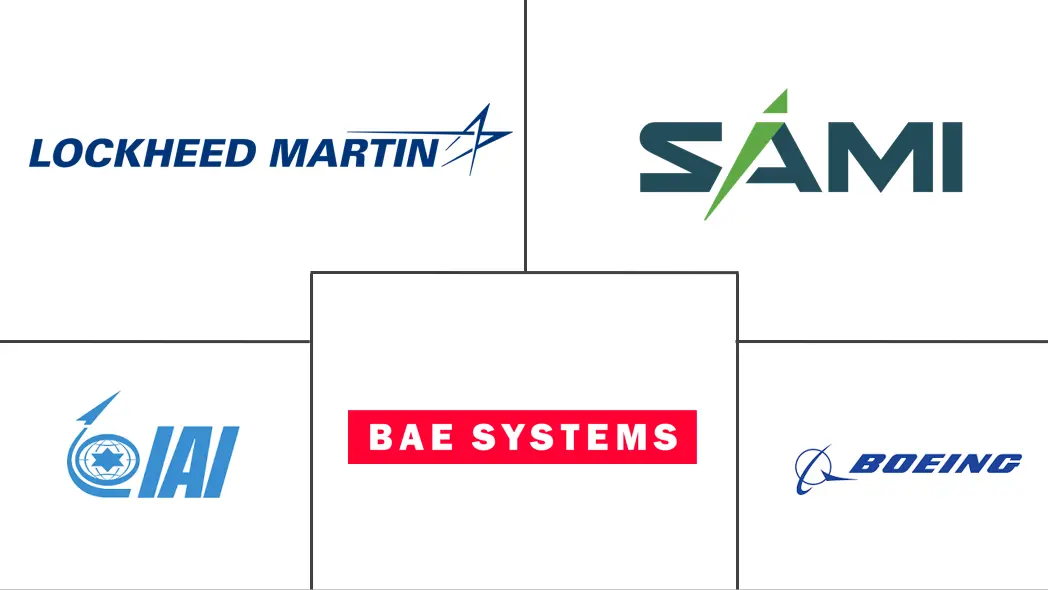Market Size of Middle East And Africa Defense Industry

| Study Period | 2019 - 2029 |
| Market Size (2024) | USD 138.41 Billion |
| Market Size (2029) | USD 177.40 Billion |
| CAGR (2024 - 2029) | 5.09 % |
| Fastest Growing Market | Middle East |
| Largest Market | Middle East |
Major Players
*Disclaimer: Major Players sorted in no particular order |
Middle East And Africa Defense Market Analysis
The Middle East And Africa Defense Market size is estimated at USD 138.41 billion in 2024, and is expected to reach USD 177.40 billion by 2029, growing at a CAGR of 5.09% during the forecast period (2024-2029).
The Middle East and African defense market is recording a rise in defense spending, fueled by increasing geopolitical tensions, local and regional conflicts, and increased spending by major countries. Saudi Arabia, the United Arab Emirates, Israel, and Egypt top this list as they continue to pour billions of dollars into the modernization of their military equipment.
The MEA defense market is increasingly focused on advanced technology inlay, ranging from artificial intelligence integration to cyber warfare capabilities and electronic warfare systems. The region is also witnessing the escalation of cooperation with leading global defense manufacturers for technology transfer and local production.
One of the most prominent drivers of the MEA defense market is the geopolitical instability and regional conflicts that prevail at a very high level. Countries within the Middle East and Africa are often embroiled in border disputes, internal conflicts, and counter-terrorism operations that require them to invest heavily in the modernization and expansion of their defense capabilities. For example, ongoing tensions between Iran and several GCC countries, as well as conflicts in Yemen, Libya, and Syria, have made countries like Saudi Arabia, the United Arab Emirates, and Israel focus on defense spending. These countries acquire advanced military hardware, including missile defense systems, fighter jets, and unmanned aerial vehicles (UAVs), to strengthen strategic deterrence and operational readiness. Such advanced defense technology contributes to national security and fosters regional stability; hence, demand for cutting-edge defense solutions is surging.
A major challenge facing the Middle East and African (MEA) defense market is the intricate balance between advancing defense capabilities and addressing fiscal constraints amid economic uncertainties. The fluctuating oil prices, exacerbated by geopolitical tensions and global economic fluctuations, significantly impact the defense budgets of oil-dependent economies in the region. For instance, the recent volatility in oil markets due to global economic slowdowns and shifts in energy policies has put pressure on defense spending. While investing heavily in defense modernization, countries like Saudi Arabia and the United Arab Emirates face the challenge of sustaining high defense expenditures while investing in economic diversification and infrastructure projects as part of their Vision 2030.
Additionally, the region's reliance on foreign defense suppliers and the complexities associated with international defense trade, including sanctions and export control regulations, further complicate procurement processes. The dynamic geopolitical landscape, characterized by alliances and rivalries, adds another layer of complexity to defense acquisitions and strategic planning. For example, ongoing sanctions on countries like Iran and the potential for new sanctions on other regional players can disrupt supply chains and delay critical defense projects. These fiscal and geopolitical challenges require careful navigation to ensure that defense modernization efforts do not compromise broader economic stability and development goals.
Middle East And Africa Defense Industry Segmentation
The Middle East and African defense market analyzes different defense equipment used to maintain the region's military strength. The study covers all aspects and is expected to provide insights into budget allocation and spending in the Middle East and African defense market during the forecast period.
The Middle East and Africa defense market is segmented into procurement, MRO, and geography. By procurement, the market is segmented into personnel training and protection, communication systems, weapons and ammunition, and vehicles. Vehicles include land, air, and sea-based vehicles. MRO segments the market into communication systems, weapons, ammunition, and vehicles. The report also covers the market sizes and forecasts for the major countries across the region. The market sizing and forecasts have been provided in value (USD).
| Procurement | |||||
| Personnel Training and Protection | |||||
| Communication Systems | |||||
| Weapons and Ammunition | |||||
|
| MRO | |
| Communication Systems | |
| Weapons and Ammunition | |
| Vehicles |
| Geography | |
| Saudi Arabia | |
| Turkey | |
| Israel | |
| Egypt | |
| Algeria | |
| South Africa | |
| Morocco | |
| Rest of Middle East and Africa |
Middle East And Africa Defense Market Size Summary
The Middle East and Africa defense market is experiencing significant growth, driven by increased defense spending due to geopolitical tensions and regional conflicts. Countries such as Saudi Arabia, the United Arab Emirates, Israel, and Egypt are leading this surge by investing heavily in the modernization of their military capabilities. The focus is on integrating advanced technologies, including artificial intelligence, cyber warfare, and electronic warfare systems, to enhance national security and regional stability. The market is also witnessing increased collaboration with global defense manufacturers for technology transfer and local production, further bolstering the defense industrial base in the region. However, the market faces challenges such as fiscal constraints due to fluctuating oil prices and the complexities of international defense trade, which require careful navigation to balance defense advancements with economic stability.
The vehicle segment is anticipated to be a rapidly growing area within the defense market, fueled by the need for modern armored vehicles to address regional security threats. Countries like Saudi Arabia and the United Arab Emirates are at the forefront of this segment, investing in advanced systems and strategic partnerships to enhance their defense capabilities. Additionally, the adoption of unmanned aerial vehicles (UAVs) is on the rise, with countries such as Saudi Arabia, the United Arab Emirates, and Israel expanding their UAV arsenals through both local production and international cooperation. The market is characterized by a fragmented landscape with both regional and international players, including prominent companies like Boeing, Lockheed Martin, and Saudi Arabian Military Industries, contributing to the diverse range of military products and solutions available. Government initiatives, such as Saudi Arabia's Vision 2030, are further driving the localization of defense manufacturing, reducing foreign dependence, and fostering technological advancements in the region.
Middle East And Africa Defense Market Size - Table of Contents
-
1. MARKET DYNAMICS
-
1.1 Market Overview
-
1.2 Market Drivers
-
1.3 Market Restraints
-
1.4 Porter's Five Forces Analysis
-
1.4.1 Bargaining Power of Buyers/Consumers
-
1.4.2 Bargaining Power of Suppliers
-
1.4.3 Threat of New Entrants
-
1.4.4 Threat of Substitute Products
-
1.4.5 Intensity of Competitive Rivalry
-
-
-
2. MARKET SEGMENTATION
-
2.1 Procurement
-
2.1.1 Personnel Training and Protection
-
2.1.2 Communication Systems
-
2.1.3 Weapons and Ammunition
-
2.1.4 Vehicles
-
2.1.4.1 Land-based Vehicles
-
2.1.4.2 Sea-based Vehicles
-
2.1.4.3 Air-based Vehicles
-
-
-
2.2 MRO
-
2.2.1 Communication Systems
-
2.2.2 Weapons and Ammunition
-
2.2.3 Vehicles
-
-
2.3 Geography
-
2.3.1 Saudi Arabia
-
2.3.2 Turkey
-
2.3.3 Israel
-
2.3.4 Egypt
-
2.3.5 Algeria
-
2.3.6 South Africa
-
2.3.7 Morocco
-
2.3.8 Rest of Middle East and Africa
-
-
Middle East And Africa Defense Market Size FAQs
How big is the Middle East And Africa Defense Market?
The Middle East And Africa Defense Market size is expected to reach USD 138.41 billion in 2024 and grow at a CAGR of 5.09% to reach USD 177.40 billion by 2029.
What is the current Middle East And Africa Defense Market size?
In 2024, the Middle East And Africa Defense Market size is expected to reach USD 138.41 billion.

